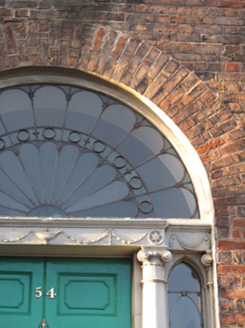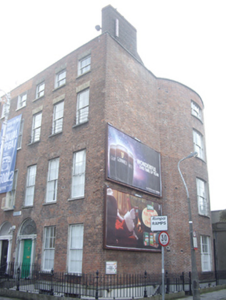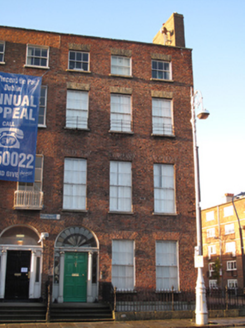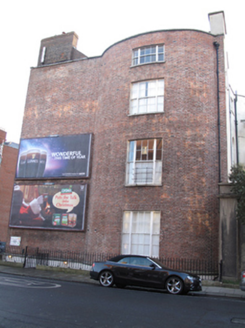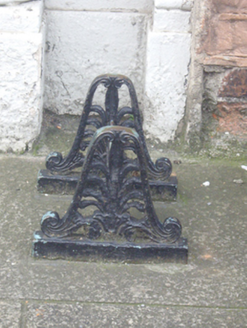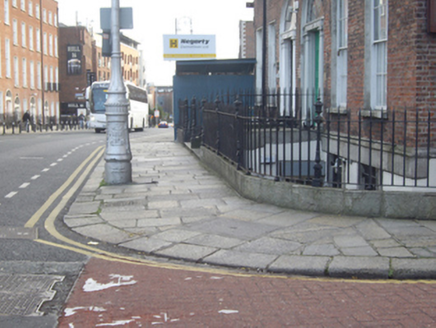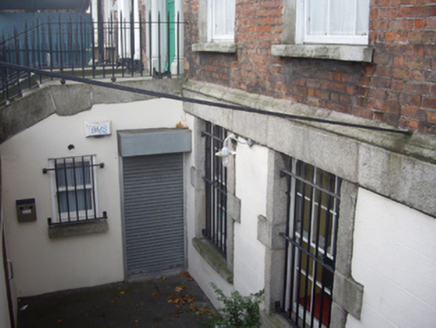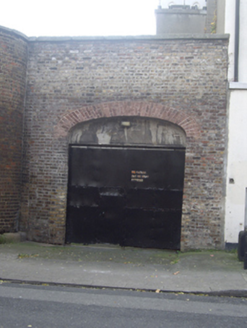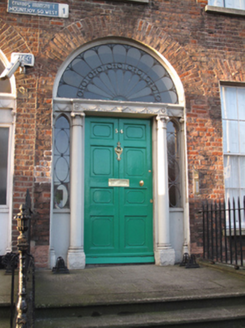Survey Data
Reg No
50010955
Rating
Regional
Categories of Special Interest
Architectural, Artistic
Original Use
House
In Use As
Apartment/flat (converted)
Date
1785 - 1795
Coordinates
316029, 235314
Date Recorded
09/12/2011
Date Updated
--/--/--
Description
Corner-sited end-of-terrace three-bay four-storey house over exposed basement, built, 1790, with full-height bow to north side elevation. Built as one of pair and forming external southwest corner of Mountjoy Square. Now in mixed use. Double-pile natural slate roof with pair of rear projections set perpendicular to front pitch, that to south shared with adjoining house, and shallow bowed roof over north bow. Large yellow brick chimneystack rising from north gable with further rendered chimneystack rising from rear gable. Roof behind rebuilt parapet wall with granite coping and cast-iron rainwater goods breaking through to rear. Red brick walls laid in Flemish bond with remnants of original lime pointing, recently lime pointed to north side elevation. Chamfered granite plinth course over ruled-and-lined rendered basement walls. Painted rendered walls to rear elevation. Gauged brick flat-arched window openings with granite sills, flush rendered reveals and replacement timber sliding sash windows throughout, six-over-six pane to lower floors and three-over-three pane to top floor. Wrought-iron window guards to second floor and wrought-iron grilles to basement windows with some granite surrounds. Bow has replacement Wyatt timber sliding sash windows with gauged brick lintels of former openings to either side on ground and first floors. Gauged brick round-arched door opening with Portland limestone Ionic doorcase. Replacement timber door with decorative panels and brass furniture flanked by engaged Ionic columns on plinth blocks, Gothic-arched sidelights with replacement lead tracery and quarter engaged Ionic pilasters supporting stepped lintel cornice with festoon motifs and replacement leaded fanlight. Door opens onto granite platform with pair of original cast-iron bootscrapers and four nosed granite steps bridging basement. Platform and basement enclosed by original wrought-iron railings and cast-iron corner posts on moulded granite plinth wall. Railing returns to north side elevation with matching iron gate providing basement access via steep steps. Rendered wall and yellow brick screen wall abuts rear elevation with elliptical carriage arch opening into rear yard. Single-storey modern return with flat roof abuts rear elevation. Yard partially surfaced in red sandstone flagstones and original cobblestones.
Appraisal
No. 54 and its pair to the south were the first buildings on Mountjoy Square to be completed, in 1792, and were built by William Pemberton, a bricklayer, who took other plots on the West side, and resided in No. 54 for a number of years. Taking advantage of the prominent corner site on the main thoroughfare of the Gardiner Estate, Pemberton used the standard mid-terrace plan, but added a long bow, which contains the only oval rooms in a terraced townhouse in the city. The house retains most of its original joinery including a fine timber staircase, and relatively simple plasterwork and a well-presented exterior. The house had fallen into tenement use by the early nineteenth century and was saved from destruction in the 1960s by the efforts of the Irish Georgian Society and associated conservationists with high quality elements reinstated, making a significant contribution to the appearance of the square as a whole. Mountjoy Square was built on lands formerly belonging to St. Mary’s Abbey and laid out in 1790 by Luke Gardiner II, completed by 1818. Originally called Gardiner Square, the plan was to develop a strong vista from Custom House to Mountjoy Square then on to the intended Royal Circus. Although failing to achieve his original ambitious plan for a palace façade with flanking domed pavilions, Mountjoy Square is more carefully laid out than the city’s other Georgian squares. It is symmetrical and has a unified parapet height and the east-west approaches offset to create a sense of enclosure After falling into serious neglect and dereliction throughout the twentieth-century resulting in the loss of one third of its original buildings, the square has since been repaired.
